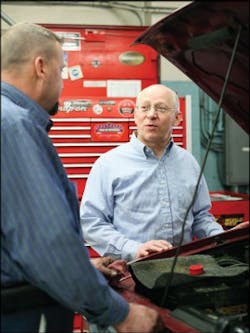It’s a 200-mile drive between Yakima, Wash., and Portland, Ore. Bill Davis knows that drive a little too well.
For seven months, he and his wife woke up before sunrise on Monday and drove the four hours or so from Christie’s Automotive in Yakima to Art of Maintenance in Portland.
They’d work all week at Art of Maintenance, trying to get their new shop running efficiently. Then they’d drive back to Yakima Saturday morning, and work all weekend at Christie’s, picking up the pieces at their original business.
Seven days a week, 12–14 hours a day for seven months, Davis tried to make it work, while money continued to leak from both businesses.
“We had to figure it out, we had to keep both shops going,” says Davis, 61. “We just didn’t know how we were going to do it.”
The Backstory
Davis bought Christie’s Automotive in 2004, after managing the shop for nine years.
From 2000 to 2003, Christie’s did almost exactly $360,000 each year in sales.
By 2008, Davis had increased revenues by 45 percent, using a new focus on marketing (the shop did basically no marketing before he took over) while also focusing more on customer relations.
Things were going so well that in 2008, Davis started looking for new ways to expand his shop.
Davis is an avid reader, and a quote from the autobiography of Conrad Hilton (founder of Hilton Hotels) stuck out in his mind as he began contemplating a second location: “If you’re going to launch big ships, you have to go where the water is deep,” Davis remembers reading.
He knew Yakima (with a population of just about 92,000) was too small to try to launch a second shop. So, he started looking where the “water was deeper” in areas like Seattle and Portland.
Eventually he found a Portland shop—Art of Maintenance—that was up for sale. It had a good crew, was doing solid business already and had a great location in a large metropolitan area.
Davis jumped at it.
The Problem
“Having only one shop, you really don’t know what it’s like having another shop, let alone one that’s a good distance away,” Davis says. “No matter how much research you do, it’s hard to really know what to expect.”
At first, it seemed fairly simple: Davis had a great crew at Christie’s to hold down the fort while he got everything up and running at Art of Maintenance. And at the new shop, he had experienced and skilled employees including a long-tenured husband-and-wife duo that Davis trusted to manage the shop on the days he wasn’t there.
Davis thought it all seemed perfect—until it wasn’t.
To start, Davis split his time at the two shops: three days in Portland and just two days each week at his original shop in Yakima.
Sales fell dramatically at Christie’s without him there—more than 20 percent in the first 12 months.
At the new shop, which was a roughly $500,000 business when Davis took over, the husband-and-wife duo weren’t up for the task, and not only did sales drop slightly but overall operations were a mess, Davis says.
Throw in that the U.S. economy collapsed only about two months after Davis’ purchase, and you can get a glimpse of the enormity of the issues.
“It wasn’t good,” Davis says. “We went from looking at this great growth opportunity and were suddenly losing money. We needed to figure out something fast.”
The Options
Being honest, Davis says he wasn’t sure how to proceed. He knew he could try to sell the Portland shop and go back to just running Christie’s. He could sell Christie’s. Or he could dump them both.
Those were the simple ways out, though certainly not the most attractive.
What Davis wanted was a way to make it work.
“Failing was not going to be an option,” Davis says. “There was no way I was going to let either shop fail, despite the economy, despite all the other issues. I just wasn’t going to let that happen.”
The Decision
Those long drives from Yakima to Portland, Portland to Yakima, proved to be helpful for Davis and his wife.
“To pass the time, we’d listen to business books and some text books and college courses and things like that,” Davis says. “One of the first books we listened to was The E-Myth Revisited by Michael Gerber. That changed everything.”
The E-Myth Revisited focuses on systematizing your business and ways to develop into a true manager—working on your business, not in it.
Davis wanted to learn more and contacted the E-Myth International consulting program and began working in their mastery program.
THE EXPERTS WEIGH IN
Dave Schedin, principal consultant, CompuTrek Automotive Management Systems
The steps Bill took were actually the correct ones. He did everything right: He got to the point where it was all about systems—creating procedures and putting people in the right places—and one of the biggest steps was making sure he had the right people to pull it off. He did everything right. It just took him too long to do it. He could’ve likely sped things up by getting help from someone within the industry, and getting it sooner than he did. He needed a thorough forecasting budget before setting out. To make a big move like this, he should’ve had a plan for where he’d be in 12 months, 24 months, three years, and how he was going to get there. All of this needed to be done early on, not when everything started to fall apart.
Ruth Weniger, consultant, Powerful Business Strategies, LLC
Rule No. 1: You don’t know what you don’t know. Rule No. 2: You can’t fix what you don’t know. Rule No. 3: If you are going to take advice, be sure your advisor understands your unique business and challenges. Applying a grand, sweeping comment from famed hotelier Conrad Hilton to their business almost got the Davises into a fatal situation. Successful as he is, Mr. Hilton is as distant from the operational realities of Davis’ business as the Davises are from hotels. As they learned in The E-Myth Revisited, a small business owner must ensure that sound business systems are in place in order to create sustainable growth. The value of defined and documented systems throughout your business will solve challenges you didn’t even realize you were facing. That means reviewing every process, procedure and policy across your whole business to ensure your success.
“We worked with a coach for about a year, learning basic business principles, but also learning to introduce basic systems and principles into our business that would allow us to run it without us having to be there,” Davis says.
And along the way, they began making changes.
As Art of Maintenance continued to struggle, Davis laid off half of the husband-wife team in charge. The other half immediately quit.
Until finding a suitable replacement, Davis took over day-to-day operations.
Meanwhile, Davis made changes at his initial shop, promoting his remaining service advisor to shop manager. One mistake Davis says he made initially was not trusting the service advisor to fully run the shop, which he says he was very capable of and qualified to do.
Davis then started implementing more systems. He created a new hiring program for the two shops, focusing on looking at “ideal candidates that fit the company’s culture.”
He changed that, too: the culture of the shop.
For years, he went with the philosophy of only taking in “the right customers.” He says that wasn’t an option when he didn’t have enough customers to pay the bills. He opted for a new plan of looking at his service strategy the way a restaurant would.
“People don’t come to a restaurant to hear they can get their meal in four hours or two days,” he says. “And from what I’ve found, customers are the same way with their car repairs. They want it done now.”
Both shops stopped turning away customers. Through more efficient workflow systems, the shops handled heavier workloads with the same staff and churned out jobs at a quicker rate.
To attract new customers (and bring back the old ones), Davis also began a new direct marketing campaign, through mailers and email.
The Aftermath
In 2012, Art of Maintenance generated more than $1.1 million in revenue. Christie’s was back up above the $500,000 mark.
Davis hired new staff members at each facility, filling all vacant positions from prior layoffs and adding new team members to grow the businesses. Each shop now has a manager, at least one separate service advisor and at least four full-time technicians (Art of Maintenance has six). Using his new hiring system, Davis says, all the new hires have been successful in their roles so far.
“It’s one of those things where the numbers can explain the outcome a little better than I can,” Davis says.
And there’s this: Davis is not required to have a day-to-day role in either shop anymore. He focuses solely on the overall strategies for both businesses.
Plus, he’s putting far fewer miles on the family car these days.
The Takeaway
In hindsight, Davis says he sees plenty of red flags that should’ve warned him he wasn’t ready—and his business wasn’t ready—for the expansion.
If he could give advice to shop owners thinking of opening a second location, he says it would be three simple tips.
First, your original shop has to run efficiently without you there, he says. Systems need to be in place that allow the business to run itself.
Second, Davis says you need to have a good marketing strategy for the new shop. How are you going to get customers? Where are they coming from? Whom do you want to come to you? You have to have a thorough plan, Davis says.
And last, Davis says you need to be financially sound. He suggests having enough reserves to cover at least six months of operational costs for your original shop in case something goes wrong.
“If you’re keeping track,” Davis jokes, “I wouldn’t have opened my second shop under my own criteria.”
Davis says that the proper plan makes owning multiple shops possible, even if they’re far apart. And it makes running a single facility that much more efficient.
“Just applying all that I learned to one shop helps tremendously,” he says. “You can grow your business through systems and procedures. It’s an ongoing thing, and you’ll never really be done putting systems in, but it’s the systems that make that distance between your shops that much shorter.”
About the Author

Bryce Evans
Bryce Evans is the vice president of content at 10 Missions Media, overseeing an award-winning team that produces FenderBender, Ratchet+Wrench and NOLN.
